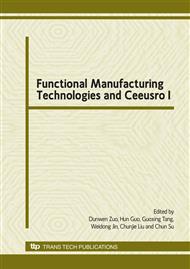p.216
p.220
p.225
p.230
p.235
p.240
p.245
p.249
p.254
Research and Implement of Automated Eliminating Bubbles Method Oriented to Vacuum Casting
Abstract:
This paper proposed a new method of automated eliminating bubbles based on vision sense technology because detection and elimination of bubbles of injection materials is key factor which influences the quality of products and hinders realization of full automatic control for the vacuum casting. This method uses vision sensor to replace artificial visual measurement, and adopts processing of the bubbles images to judge the effect of eliminating bubbles instead of experiences of operators. This paper developed a bubbles monitoring control system to realize the automated eliminating bubbles method. The system adopts two-level distributed structure which is consisted of host and slave computers. The slave computer is composed of image acquisition module, controller module and execution module. It is responsible for controlling operation devices to finish vacuum casting. The host computer is responsible for supervisory control which includes human-machine interface module, camera control module and images analysis and processing module. The function of every module is described in detail. The operator is just needed to set relative parameters, and then the system will implement automatically. In a word, the controlling system based on this new method possesses some advantages such as high precision, efficiency and flexibility.
Info:
Periodical:
Pages:
235-239
Citation:
Online since:
January 2010
Authors:
Keywords:
Price:
Сopyright:
© 2010 Trans Tech Publications Ltd. All Rights Reserved
Share:
Citation:


